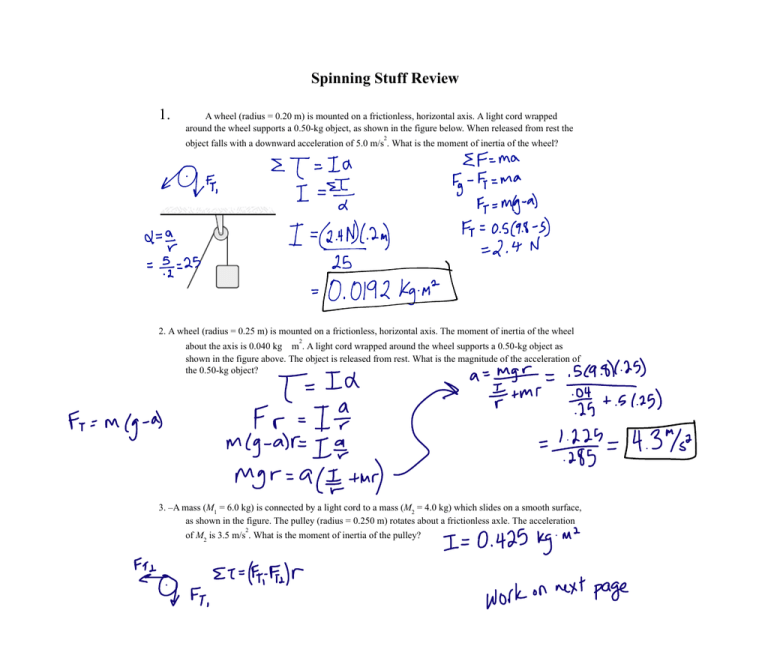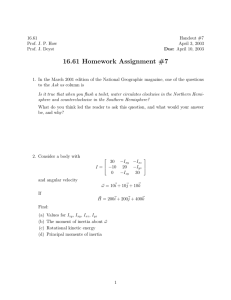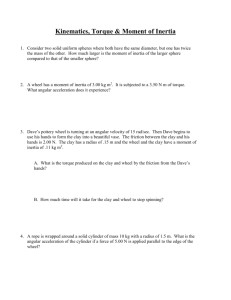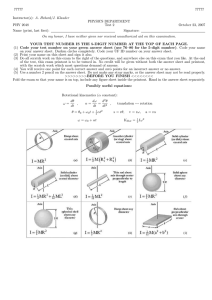Spinning Stuff Review 1.
advertisement

Spinning Stuff Review 1. A wheel (radius = 0.20 m) is mounted on a frictionless, horizontal axis. A light cord wrapped around the wheel supports a 0.50-kg object, as shown in the figure below. When released from rest the 2 object falls with a downward acceleration of 5.0 m/s . What is the moment of inertia of the wheel? 2. A wheel (radius = 0.25 m) is mounted on a frictionless, horizontal axis. The moment of inertia of the wheel 2 about the axis is 0.040 kg m . A light cord wrapped around the wheel supports a 0.50-kg object as shown in the figure above. The object is released from rest. What is the magnitude of the acceleration of the 0.50-kg object? 3. –A mass (M1 = 6.0 kg) is connected by a light cord to a mass (M2 = 4.0 kg) which slides on a smooth surface, as shown in the figure. The pulley (radius = 0.250 m) rotates about a frictionless axle. The acceleration 2 of M2 is 3.5 m/s . What is the moment of inertia of the pulley? 2 4. A wheel rotates about a fixed axis with a constant angular acceleration of 4.0 rad/s . The diameter of the wheel is 40 cm. What is the linear speed of a point on the rim of this wheel at an instant when that point 2 has a total linear acceleration with a magnitude of 1.2 m/s ? 5. Two particles (m1 = 0.20 kg, m2 = 0.30 kg) are positioned at the ends of a 2.0-m long rod of negligible mass. What is the moment of inertia of this rigid body about an axis perpendicular to the rod and through the center of mass? 6. Particles (mass of each = 0.20 kg) are placed at the 40-cm and 100-cm marks of a meter stick of negligible mass. This rigid body is free to rotate about a frictionless pivot at the 0-cm end. The body is released from rest in the horizontal position. What is the initial angular acceleration of the body? 7. In the figure, a 1.6-kg weight swings in a vertical circle at the end of a string having negligible weight. The string is 2 m long. If the weight is released with zero initial velocity from a horizontal position, its angular momentum (in kg 2 m /s) at the lowest point of its path relative to the center of the circle is 8. A uniform rod of mass M = 1.2 kg and length L = 0.80 m, lying on a frictionless horizontal plane, is free to pivot about a vertical axis through one end, as shown. The moment of inertia of the rod about this axis is 2 given by (1/3)ML . If a force (F = 5.0 N, acceleration about the pivot point? = 40 ) acts as shown, what is the resulting angular 9. A uniform rod of length (L = 2.0 m) and mass (M = 1.5 kg) is pivoted about a horizontal frictionless pin through one end. The rod is released from rest at an angle of 15 below the horizontal. What is the angular speed of the rod when it passes through the vertical position? (The moment of inertia of the rod about the pin is 2.0 kg 2 m .) 10. A uniform rod (length = 2.4 m) of negligible mass has a 1.0-kg point mass attached to one end and a 2.0-kg point mass attached to the other end. The rod is mounted to rotate freely about a horizontal axis that is perpendicular to the rod and that passes through a point 1.0 m from the 2.0-kg mass. The rod is released from rest when it is horizontal. What is the angular velocity of the rod at the instant the 2.0-kg mass passes through its low point? 11. A disc with moment of inertia I is rotating freely in a horizontal plane about its center with angular velocity ω. A bug of mass m lands at the center of the disc and then walks outward. When the bug has reached a distance R from the center, the angular velocity of the system will be 12. A body with moment of inertia 20 kg m is rotating about a fixed axis with an angular velocity . a. Through what angular displacement will the body move in the first 2 seconds? 2 b. What is the net torque exerted on the object at t = 3s? 13. What is the angular momentum of the moon about the Earth? The mass of the moon is 7.35 5 22 10 kg, the center-to-center separation of the Earth and the moon is 3.84 10 km, and the orbital period of the moon is 27.3 days. Ignore the small offset of the center of mass of the system from the center of the Earth in your calculation. A mass of mass m is attached to a pulley of mass M and radius R. The mass is released from rest and the pulley is allowed to rotate freely without friction. a. Draw free-body diagrams for the mass and the pulley on the diagrams below. b. If the mass of the block is 0.20 kg and the mass of the pulley is 0.50 kg with a radius of 0.25 m, calculate the linear acceleration of the block. c. During an experiment, a student determines the actual acceleration of the block is 3.5 . What is the torque due to friction? m s2 1990M2. A block of mass m slides up the incline shown above with an initial speed v in the position shown. a. If the incline is frictionless, determine the maximum height H to which the block will rise, in terms of the given quantities and appropriate constants. b. If the incline is rough with coefficient of sliding friction m, determine the maximum height to which the block will rise in terms of H and the given quantities. O A thin hoop of mass m and radius R moves up the incline shown above with an initial speed v in the position shown. c. If the incline is rough and the hoop rolls up the incline without slipping, determine the maximum height to which the O d. hoop will rise in terms of H and the given quantities. If the incline is frictionless, determine the maximum height to which the hoop will rise in terms of H and the given quantities.



